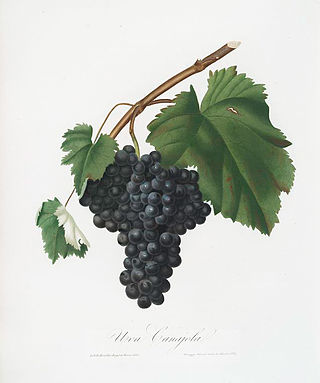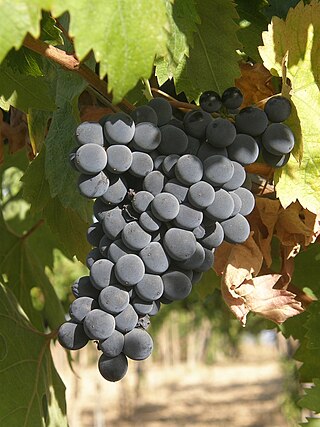
Sangiovese is a red Italian wine grape variety that derives its name from the Latin sanguis Jovis, "the blood of Jupiter". Though it is the grape of most of central Italy from Romagna down to Lazio, Campania and Sicily, outside Italy it is most famous as the only component of Brunello di Montalcino and Rosso di Montalcino and the main component of the blends Chianti, Carmignano, Vino Nobile di Montepulciano and Morellino di Scansano, although it can also be used to make varietal wines such as Sangiovese di Romagna and the modern "Super Tuscan" wines like Tignanello.

Vermentino is a light-skinned wine grape variety, primarily found in Italian wine. It is widely planted in both Sardinia and Liguria, to some extent in Corsica, in Piedmont under the name Favorita, and in increasing amounts in Languedoc-Roussillon. The leaves are dark green and pentagonal. The grapes are amber-yellow and hang in pyramidal bunches. The vines are often grown on slopes facing the sea where they can benefit from the additional reflected light. The Vitis International Variety Catalogue now gives Italy as its origin.

Canaiolo is a red Italian wine grape grown through Central Italy but is most noted in Tuscany. Other regions with plantings of Canaiolo include Lazio, Marche and Sardegna. In Umbria a white berried mutation known as Canaiolo bianco exists. Together with Sangiovese and Colorino it is often used to create Chianti wine and is an important but secondary component of Vino Nobile di Montepulciano. In the history of Chianti it has been a key component blend and during the 18th century may have been the primarily grape used in higher percentage than Sangiovese. Part of its popularity may have been the grape's ability to partially dry out without rotting for use in the governo method of prolonging fermentation. In the 19th century, the Chianti recipe of Bettino Ricasoli called for Canaiolo to play a supporting role to Sangiovese, adding fruitiness and softening tannins without detracting from the wine's aromas. In the aftermath of the phylloxera epidemic, the Canaiolo vines did not take well to grafting onto new American rootstock and the grape began to steadily fall out of favor. As of 2006, total plantings of Canaiolo throughout Italy dropped to under 7,410 acres. Today there are renewed efforts by Tuscan winemakers to find better clonal selections and re-introduce the variety into popular usage.

Montepulciano is a red Italian wine grape variety that is most noted for being the primary grape behind the DOCG wines Offida Rosso, Montepulciano d'Abruzzo, Montepulciano d'Abruzzo Colline Teramane, Rosso Conero and the DOC wine Rosso Piceno Superiore.

Tuscan wine is Italian wine from the Tuscany region. Located in central Italy along the Tyrrhenian coast, Tuscany is home to some of the world's most notable wine regions. Chianti, Brunello di Montalcino and Vino Nobile di Montepulciano are primarily made with Sangiovese grape whereas the Vernaccia grape is the basis of the white Vernaccia di San Gimignano. Tuscany is also known for the dessert wine Vin Santo, made from a variety of the region's grapes. Tuscany has forty-one Denominazioni di origine controllata (DOC) and eleven Denominazioni di Origine Controllata e Garantita (DOCG). In the 1970s a new class of wines known in the trade as "Super Tuscans" emerged. These wines were made outside DOC/DOCG regulations but were considered of high quality and commanded high prices. Many of these wines became cult wines. In the reformation of the Italian classification system many of the original Super Tuscans now qualify as DOC or DOCG wines but some producers still prefer the declassified rankings or to use the Indicazione Geografica Tipica (IGT) classification of Toscana. Tuscany has six sub-categories of IGT wines today.
Drupeggio is a white Italian wine grape variety that is grown in the Central Italy wine regions of Tuscany and Orvieto. The grape is often confused for the white Tuscan variety Vernaccia di San Gimignano, which is also known under the synonym Canaiolo bianco and may be counted as one and the same in field blends.
Uva Tosca is a red Italian wine grape variety that is grown in the Emilia-Romagna region of east-central Italy where it is the only grape variety able to grow in the higher elevations of the Val Secchia area. Despite what its name may allude to, ampelographers have little evidence to believe that the grape originated in Tuscany or has any close genetic relationship with the notable Tuscan wine grape, Sangiovese, that is also known under the synonym of Uva Tosca. In 2010, DNA analysis suggested that Uva Tosca may be a natural crossing between the Alto-Adige wine grape Schiava Grossa and Crepallocchi.

The history of Chianti dates back to at least the 13th century with the earliest incarnations of Chianti as a white wine. Today this Tuscan wine is one of Italy's most well known and recognizable wines. In the Middle Ages, the villages of Gaiole, Castellina and Radda located near Florence formed as a Lega del Chianti creating an area that would become the spiritual and historical "heart" of the Chianti region and today is located within the Chianti Classico Denominazione di Origine Controllata e Garantita (DOCG). As the wines of Chianti grew in popularity other villages in Tuscany wanted their lands to be called Chianti. The boundaries of the region have seen many expansions and sub-divisions over the centuries. The variable terroir of these different macroclimates contributed to diverging range of quality on the market and by the late 20th century consumer perception of Chianti was often associated with basic mass-market Chianti sold in a squat bottle enclosed in a straw basket, called fiasco.
Abrusco is a red Italian wine grape variety grown primarily in the Tuscany region where it is a minor blending component permitted in the wines of Chianti. The grape has long history in the region and was mentioned in 1600, under its synonyms Abrostino and Colore, in the posthumously published work by Italian agronomist Giovan Vettorio Soderini Trattato della coltivazione delle viti, e del frutto che se ne può cavare. There Soderini notes that the grape was often used to add deeper, more red color to Tuscan wines.

Pecorino is a white Italian wine grape variety that grows in the Marche, Abruzzo, Tuscany, Umbria and Lazio regions of Italy. Ampelographers believe that the grape is likely native to Marche, where the soil destined for this cultivation increases every year. This grape variety is used to produce the DOCG wines, like the Offida Pecorino DOCG, and the DOC wines, like the Falerio dei Colli Ascolani, the Colli Maceratesi and the Falerio dei Colli Ascolani.
Verdea is a white Italian wine grape variety that originated in Tuscany but is today mainly grown in the Lombardy wine region of northern Italy. The grape is sometimes confused with the white Verdeca grape of the Apulia region and the French wine grape Verdesse from Savoy due to similarities in their names and synonyms. Verdea can be used to make a wide variety of wines, ranging from the late harvested Vin Santo to dry sparkling wines.
Pollera nera is a red Italian wine grape variety that is grown primarily in the Liguria wine region and northwest Tuscany. Ampelographers believe that the vine has a very long winemaking history but it is rarely seen today. It is believed to have been descended from the Chianti wine grape Mammolo and the Corsican wine grape Sciacarello which would make it a half-sibling of Colombana nera.

Colli di Luni is an Italian Denominazione di origine controllata (DOC) located in both Liguria and Tuscany in northwest Italy. The DOC produces both reds and white wines made primarily from Sangiovese and Vermentino with a varietal Vermentino also being produced in the DOC.

Abruzzo is an Italian wine region located in the mountainous central Italian region of Abruzzo along the Adriatic Sea. It is bordered by the Molise wine region to the south, Marche to the north and Lazio to the west. Abruzzo's rugged terrain, 65% of which is mountainous, help to isolate the region from the winemaking influence of the ancient Romans and Etruscans in Tuscany but the area has had a long history of wine production.
Bracciola nera is a red Italian wine grape variety that is primarily found in the Liguria and Toscana wine regions of western Italy. The only Denominazione di origine controllata (DOC) that Bracciola nera plays a significant role is in the Colli di Luni DOC of Ligura where the grape is permitted to be blended with Sangiovese, Canaiolo, Pollera nera, Ciliegiolo, Vermentino nero and other varieties. A late-ripening variety, Bracciola nera usually contributes acidity to blends.
Colombana nera is a red Italian wine grape variety that is grown in Emilia-Romagna and Tuscany. Despite similarities in name, the grape did not get its name from nor is it grown in the San Colombano al Lambro region of Lombardy nor is it permitted in the Denominazione di origine controllata (DOC) wine of the same name. Rather, ampelographers believe that Colombana nera is named after the Abbey of San Colombano located in the commune of Bobbio in the Piacenza province of Emilia-Romagna where the grape has had a long history of cultivation.

Vermentino nero is a red Italian wine grape variety that is predominantly grown in province of Massa-Carrara in Tuscany. After World War II, the vine was almost lost to extinction until Podere Scurtarola, a producer from Massa, began replanting old vineyards with the grape. By 2000, there were 199 hectares of Vermentino nero growing in Italy with the grape authorized for production in the Denominazione di origine controllata (DOC) wines of Candia dei Colli Apuani and Colline Lucchesi.
Verdello is a white Italian wine grape variety that is grown mostly in the Umbria region of central Italy where it plays a minor role as a blending grape in several Denominazione di Origine Controllata (DOC) wines, including Orvieto. Despite similarities in their names, the Italian Verdello grape has no close genetic relationship with the Portuguese wine grape Verdelho that is grown on the islands of Madeira and Azores. However, like the Portuguese grape, Verdello's name likely comes from the dark green color of its berries before veraison.
Barbera del Sannio is a red Italian wine grape variety that is grown in the Campania region of southern Italy. Despite the similarities in name and appearance, the grape has no close genetic relationship with the Piedmont wine grapes Barbera or Barbera bianca or the Sardinian wine grape Barbera Sarda and is, instead, more closely related to the Campanian varieties Casavecchia and Catalanesca and the Apulian grape Nero di Troia.
Bonamico is a red Italian wine grape variety that is grown in the province of Pisa in Tuscany where the grape has a reputation for producing very high yields. Some ampelographers speculate that the grape may have originated around the town of Palaia with the grape being known under the synonym of Uva di Palaia. While often used as a table grape, Bonamico can be a minor blending component in several Tuscan Denominazione di Origine Controllata (DOC) and Indicazione Geografica Tipica (IGT) wines where it often contributes floral aroma notes and acidity.











